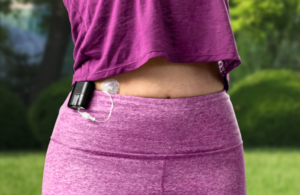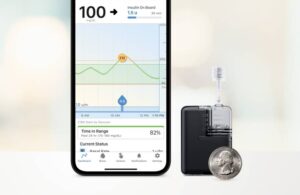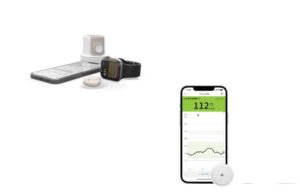
Over about two months, Tandem announced continuous glucose monitor (CGM) integration with the latest-generation technology from Dexcom and Abbott, launched its Tandem Source diabetes management platform and began the rollout of its new Mobi miniature insulin pump.
Those milestones added to the January 2023 acquisition of AMF Medical, adding a differentiated patch pump to the Tandem portfolio.
“We certainly didn’t plan that from the outset, [to] do four back-to-back releases,” Gasser said in an interview. “Sometimes that’s how technology comes out along the way. It’s made for a busy, intense year.”
Tandem’s t:slim X2 has used Control IQ automated insulin delivery (AID) software for years. But the company’s newest offering highlights another diabetes care trend: miniaturization.
Those trends of automation and miniaturization help reduce the cognitive burden for patients; Gasser said: “We can make it more wearable and more convenient.”
Tandem’s origins
Dick Allen, one of Tandem’s founding board members, encountered pumps when he had to help manage his granddaughter’s diabetes. He discovered that the insulin pump at the time was “a very funky medical device,” Gasser said, and Allen believed there had to be a better way for patients to manage diabetes
“It’s fundamental in our space and it’s been a core tenet for Tandem since inception,” Gasser said. “From day one, the company set itself the goal of thinking about how to make this feel less like a medical device and make it easier to use and more appealing from a consumer perspective.”
That mindset led to the development of Tandem’s first t:slim pump and the following iterations. It developed into the company’s pursuit of varied CGM integration, providing more options to more patients. Mobi is yet another example of a smaller, durable device created to give patients yet another option.
“These devices are on you 24/7,” Gasser said. “They’re as intimate as devices get, other than phones, which are very personal devices. Honing in on that idea of how do we make it feel more consumer and less medical is important.”

Leading the way in automation
Automation, AI, algorithms and the like have long been a hot topic in medtech.
“The arc of technology points toward miniaturization and automation,” Gasser said.
Tandem Senior Director of Medical Affairs Laurel Messer sees AID moving toward systems that require less user interaction and burden.
“This is a partnership between better algorithms and exceptional wearability,” she said. “The future will include reduced user input, potentially getting to a point of a fully closed loop that does not require user interaction for meals. We need to relentlessly drive AID toward this goal to limit the impact and burden of diabetes on people living life.”
Tandem’s Control IQ automatically monitors and regulates blood glucose. The advanced hybrid closed-loop automated insulin delivery feature predicts and helps prevent high and low blood sugar. It leads to improved time in range throughout the day and night.
Gasser said she often invokes the Nest example when talking automation — the advent of cruise control and the capacity to implement machine learning so more and more can be done with automation. She calls it “the Nest–ification of tech,” referring to Google’s line of smart home devices.
Tandem approached this concept with Control IQ as an adaptive algorithm that can be iterated upon to continuously reduce the need for user engagement.
With diabetes, as Gasser explains it, treatment requires the administration of something physical and constant engagement. The aim is to take the physical burden out of the equation.
“Automation requires that we think about what wraps around it in terms of the user experience, that the interaction is intuitive, usable and builds trust,” Gasser said. “There’s the information that the patient makes visible through the applications themselves to help people understand their relationship with the automation. We spend a lot of time on it. It’s a significant investment.”
Making vital devices smaller
Diabetes devices are getting smaller all the time. The Dexcom G7 is 60% smaller than the G6. Abbott’s FreeStyle Libre 3 is about the size of two stacked pennies, compared to Libre 2, which is about the size of two stacked quarters.

“There’s a consistent theme across CGM and pumps rolling into miniaturization,” Gasser said.
There remain limitations, though, such as capacity on the pump side. With Mobi’s 200-unit cartridge and Sigi’s eventual 160-unit cartridge, the company continues to create smaller devices that can still provide the necessary levels of therapy to different patients with different needs.
Gasser said that while they can “pack quite a lot in a small place,” developers will eventually reach the boundaries of what’s possible — at least in a durable way. However, the company believes that its options and their shrinking sizes will enable more choice among patients.
“We’re allowing people to customize form factor, capacity and wearability to how they want to engage with their insulin therapy,” Gasser said.
They said it: Diabetes tech leaders discuss current trends
Insulet EVP of Innovation and Strategy Eric Benjamin on the space’s consumer-centric nature:
“They are medical devices. They are also consumer devices. We live at the intersection of those two things. Diabetes is such a personal experience and decisions are influenced by the care team, but the ultimate choice is made by the person with diabetes. That’s central to how we think about it.”

“People managing their diabetes like to be in control. But after a week or so, they realize how much their system is doing for them. The thing we’re reminding them of is that they can get better outcomes with less work. As a result of that, they’re actually quite excited to get it.”
Dexcom COO Jake Leach on the role of consumer choice and automation:
“We’ve prioritized connectivity for more than a decade, which means our CGM systems are optimized to seamlessly connect with insulin delivery and digital health partners of all kinds, giving users freedom of choice in their diabetes journey and making Dexcom the clear choice for AID.”
Marc Taub, Abbott Diabetes DVP, Technical Operations, on the consumer focus in diabetes tech:
“It’s really where medical device meets consumer electronics. People have this amazingly intimate relationship with their sensor. They’re wearing it on the back of their arm. They’re wearing it every day. They sleep with it. They shower with it. They’re looking at the results on their phone up to dozens of times a day.”

